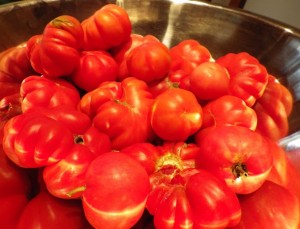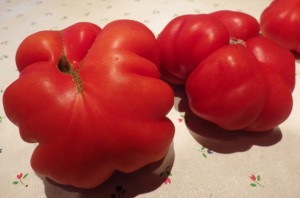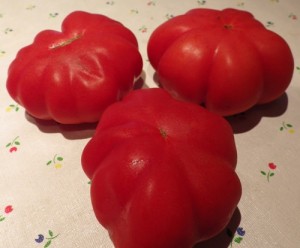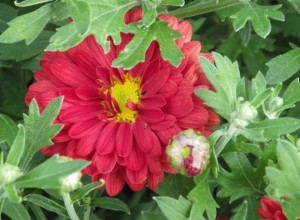 Well, your old Aunty got skunked. Oh yes I did. My fault, completely – nothing like saving tomato seeds and then not labeling them properly. Somehow ‘Paste Tomatoes from 2014″ just doesn’t cut it because what I thought I was going to get were plum-type past tomatoes (like San Marzano), but instead, I got THESE!
Well, your old Aunty got skunked. Oh yes I did. My fault, completely – nothing like saving tomato seeds and then not labeling them properly. Somehow ‘Paste Tomatoes from 2014″ just doesn’t cut it because what I thought I was going to get were plum-type past tomatoes (like San Marzano), but instead, I got THESE!
Now, technically speaking, these ARE paste tomatoes – they are much dryer than salad or beefsteak-type tomatoes, but you tend to get far fewer on a plant, which is pretty annoying if what you are looking for is big production for canning or freezing sauce.
Grumble.
But to move on. Since the project is always to save the best (and eat the rest), I needed to evaluate these tomatoes to save. They are the first to ripen (earliest is always good) and there are various sizes (also good for evaluation) and there are aspects here which provide some good comparisons for decision making.
Again, as with the garlic, it all depends on what you are selecting for – what is important to YOU. Is it size? Biggest is generally best, but not necessarily – check out this photo of the two largest tomatoes. Big, yes, but there is some weird and not very attractive business going on in the bottom, probably blossom end rot due to lack of soil calcium. But not all of them have that issue. There are slightly smaller ones which don’t have those issues on the bottom at all.
Big, yes, but there is some weird and not very attractive business going on in the bottom, probably blossom end rot due to lack of soil calcium. But not all of them have that issue. There are slightly smaller ones which don’t have those issues on the bottom at all.
 See? this tomatoes are slightly smaller but no blossom end issues. On the other hand, though (and I didn’t take photos of the tops; you’ll just have to take my word on this), this smaller, seemingly perfect tomatoes have splits and other faults in the tops. Oh me, oh my – how to choose? Blossom end rot is one of those faults that is dependent on soil health — mmmm, and I’m not terribly sophisticated about this so I went with the largest, most perfect tomato.
See? this tomatoes are slightly smaller but no blossom end issues. On the other hand, though (and I didn’t take photos of the tops; you’ll just have to take my word on this), this smaller, seemingly perfect tomatoes have splits and other faults in the tops. Oh me, oh my – how to choose? Blossom end rot is one of those faults that is dependent on soil health — mmmm, and I’m not terribly sophisticated about this so I went with the largest, most perfect tomato.
I took out my spoon, opened up the tomato, scooped out a couple of spoonfuls of seeds and their gel, put them into a container with a bit of water, sealed the container and put it on the window sill to ferment for a few days, when I can pour off the liquid (and it will look nasty) put the seeds on a paper towel and dry them, then seal them up in a plastic bag and put them in the fridge for next year.
OH. And I labeled them with the words ‘large wrinkly paste tomatoes, 2015’ on them. That should help.
What else are we evaluating this year?
Well, one of my bugaboos (and we’re moving out of veggies and into flowers) is that I absolutely adore chrysanthemums. This is one of those ‘comfort foods’ of childhood, if you know what I mean. When I was a child, my dad used to bring my mom big ‘hardy’ mum plants (if you frequent your local ‘big box’ home center or local nursery, at this point in the year, there are usually huge displays of what they are calling ‘hardy’ mums, which are sold by the millions in the United States every year). My dad loved the more unusual colors such as rust. And we used to have them a lot when I was young.
Commercial mum growing is a huge business in the US. Sometimes consumers don’t even take them out of the pots; they just sink the pots into the ground or put them on the steps to make a colorful display which theoretically will withstand several nasty frosts until winter sets in. Now, if you live in Zone 6 or so, you have a decent shot that if you mulch them late in the fall before the ground freezes and then get some snow to cover them up, the plants might, if you are lucky, live through the winter. You can trim them back in the spring and you might get a few flowers the next year. But the plants really are not bred for perennial growing and even if you do get flowers the next year, they will not be a very attractive plant (commercial growers do a lot of work pinching back the baby plants to get them to form this very uniform mound in the pots) and they usually die in the second winter.
A couple of years ago, I found a very attractive, though a big ungainly perennial chrysanthemum which grew pretty well for us here. This past winter, it was hit hard and struggled back, which makes me happy because it’s one of those things that is in blossom when other things are not, so the bees like it a lot. But I was never able to find any other perennial mums which at least claimed to be hardy to zone 4.
 Until early this spring when I stumbled on mums which had been bred by the University of Minnesota (and sold through Faribault Growers ). Now, they claim they are truly winter hardy, so I decided to trail some this year. Now, putting them into the garden is one thing. Even getting them to grow this summer is another, and frankly, I gave them as neglectful an amount of attention as I could muster since anything that will get a place in the garden at Chez Siberia has to be something that I don’t have to coddle.
Until early this spring when I stumbled on mums which had been bred by the University of Minnesota (and sold through Faribault Growers ). Now, they claim they are truly winter hardy, so I decided to trail some this year. Now, putting them into the garden is one thing. Even getting them to grow this summer is another, and frankly, I gave them as neglectful an amount of attention as I could muster since anything that will get a place in the garden at Chez Siberia has to be something that I don’t have to coddle.
So far, I’ve been very very pleased with the results.
 These photos are only a few of the mums we are trialing this year (I could not possibly put photos of all of them). In general, what I’ve found with them is the following:
These photos are only a few of the mums we are trialing this year (I could not possibly put photos of all of them). In general, what I’ve found with them is the following:
First, I don’t have the time to pinch and prune mums into any specific bonsai shaping. With mums, what you want is a plant which will put its flowers over the top of the leaves or at the top of the leaves so that you can see them. So far, the plants have come through like champs in that regard. I’m sure if someone were to do a bit of pinching or pruning, they’d look even tidier and better.
 Second, the shapes and colors are generally spectacular, but for anyone looking for an honest-to-goodness orange mum — so far, I have not seen it. Lovely pinks, yellows, mahogany reds, whites, even red over yellow, which makes an orange, but not an orange itself. But since I don’t have a selection of every single one they’ve got, perhaps I’m just missing that one item.
Second, the shapes and colors are generally spectacular, but for anyone looking for an honest-to-goodness orange mum — so far, I have not seen it. Lovely pinks, yellows, mahogany reds, whites, even red over yellow, which makes an orange, but not an orange itself. But since I don’t have a selection of every single one they’ve got, perhaps I’m just missing that one item.
Third, and this goes back to number one, the plants tend to sprawl a bit. I’m sure a bit of pruning and training (perhaps a bit of a low wire perennial ring would work) would help in this regard.
The trick will not be how well they do in the garden this summer. After all, commercial ‘hardy’ mums have done well for us. The trick will be what will survive over the winter. My plan is to give them a bit of protection, hope for plenty of snow as cover and we’ll see what comes up in the spring.
Considering how tough winters are at Chez Siberia, anything that survives here will grow and thrive anyplace!
Hope your gardens are all growing gangbusters!!
Until the next time.
